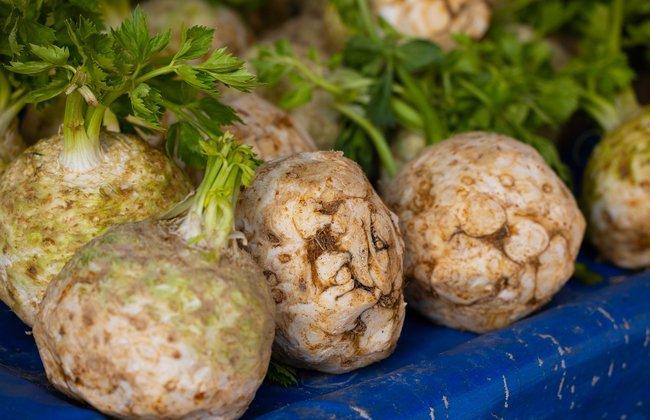New Insights on Celery Allergies and Associated Risks
- Celery is one of the main triggers of food allergies to vegetables.
- Celery allergies that are associated with a mugwort pollen allergy are linked to severe or even anaphylactic reactions.
- Sensitisation to the defensin Api g 7 from celeriac was associated with an increased risk of severe allergic reactions in a recent study.
- An immunoglobulin E test for Api g 7 could be suitable for identifying an increased risk of severe allergic reactions to celeriac in patients with mugwort pollen sensitisation.
Quote Professor Stefan Vieths
Press Release
Celery, a major cause of vegetable allergies, carries the risk of causing severe allergic reactions, especially in individuals with mugwort pollen sensitisation. A recent clinical study points to the significant role of defensin as a cross-reactive allergen in mugwort pollen (Art v 1) and celery (Api g 7) and its association with severe and potentially life-threatening allergic reactions to celery. IgE testing for Api g 7 could represent an important biomarker to identify individuals at an increased risk of anaphylaxis. The Journal of Allergy and Clinical Immunology reports on the results in its online edition dated 17 May 2024.
 Source: Engin Ekyurt/Pixabay.com
Source: Engin Ekyurt/Pixabay.com
Celery (Apium graveolens) is one of the main triggers of allergies to vegetables. It is estimated to affect around one in every 200 European adults (a prevalence of 0.45%). The symptoms associated with a celery allergy range from local reactions in the mouth area to severe anaphylaxis. The European Anaphylaxis Registry NORA (Network for Online-Registration of Anaphylaxis) identified celery as a trigger food in six % of registered adult cases. Celery is also one of the foods that caused anaphylaxis more frequently than was to be expected on the basis of celery allergy prevalence.
Celery – Risky for Allergy Patients
The two most commonly consumed celery varieties are the root (Apium graveolens var. rapaceum, also known as celeriac) and the stem (Apium graveolens var. dulce). Celery anaphylaxis is most often attributed to celeriac. Since celery root is not only consumed raw or cooked, but is also used as a spice in industrially produced compound food products, its potential as a "hidden" allergen is significant.
The risk for allergy sufferers is additionally exacerbated by the fact that the ED10 value, i.e. the lowest dose required to trigger an allergic reaction in ten percent of the allergic population, is ten times lower than the ED10 value for peanut allergies. In addition, celery allergens show resistance to thermal food processing. This makes celery a risky food for consumers with allergies. Celery and products produced from celery are subject to food allergen labelling requirements in the European Union.
Trigger for Celery-Mugwort-Syndrome
Clinical observations showed that severe systemic allergic reactions to celery occur mainly in individuals with mugwort pollen sensitisation. Mugwort (Artemisia vulgaris) is one of the main triggers of weed pollen allergies in Europe. However, the relevant cross-reactive allergens that explain the molecular basis of celery-mugwort-syndrome have still yet to be clearly identified.
In previous research conducted by an international research group led by Professor Stefan Vieths, Acting President of the Paul-Ehrlich-Institut, the defensin Api g 7 had already been identified as a possible cause of the cross-reactivity between celeriac allergy and mugwort pollen sensitisation. Defensins are small polypeptides found in all animal organisms and higher forms of plant life. They defend against microbial pathogens.
Clinical Study on the Relationship between IgE Antibodies and Allergy Severity
A research group led by Professor Stefan Vieths and Professor Barbara Ballmer-Weber (Zurich/St. Gallen) has recently conducted a comprehensive diagnostic study in patients with a confirmed celery root allergy. The aim of the study was to decipher the molecular basis of celery-mugwort-syndrome and to examine the significance of Api g 7.
A standardised survey and medical examination was conducted with 79 patients with a suspected celery allergy. The main inclusion criteria were a positive reaction after administration of small amounts of celery under controlled conditions or a clear history of severe anaphylaxis. The presence of IgE antibodies against seven celery allergens and three mugwort allergens was determined in the blood serum.
Mild symptoms in the mouth-nose-eye area were experienced by 30 of the 79 study participants and 49 of them suffered from systemic reactions, i.e. a reaction that potentially affects the entire organism. 68% had immunoglobulin E (IgE) against celery extract, 80% against birch pollen, and 77% against mugwort pollen.
IgE against Api g 7, detected in 52% of patients, correlated closely to IgE against the allergen Art v 1 from mugwort pollen. The odds of experiencing a severe anaphylactic reaction and not just mild oral symptoms were about six times higher for individuals sensitised to Api g 7 compared to individuals without sensitisation to Api g 7. The IgE diagnostic sensitivity to celery was 68% in the study population and appeared to be limited by underrepresentation of Api g 7 in the allergen extract. The sensitivity increased to over 90% with the use of a combination of purified individual allergens.
The results confirm the significant role of defensin as a cross-reactive allergen in mugwort pollen (Art v 1) and celery (Api g 7) and point to its association with severe and potentially life-threatening allergic reactions to celery.
Future studies will be needed to investigate whether homologues of Api g 7 play a similar role in severe mugwort pollen-associated spice allergies.
Original Publication
Ballmer-Weber BK, Wangorsch A, Bures P, Hanschmann KM, Gadermaier G, Mattsson L, Mills C, van Ree R, Lidholm J, Vieths S (2024): New light on an old syndrome: role of Api g 7 in mugwort 1 pollen related celery allergy.
J Allergy Clin Immunol May 17 [Epub ahead of print].
Online-Abstract
top



